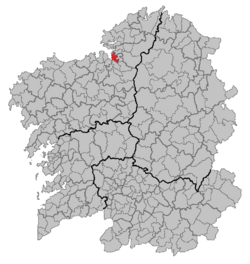Miño, A Coruña facts for kids
Miño is a charming town, also known as a municipality, located in the northwest of Spain. It's part of the province of A Coruña, which is like a county, within the larger region called Galicia. Galicia is one of Spain's 17 "autonomous communities," which means it has its own government and culture, similar to a state. Miño is also part of a smaller area known as the comarca of Betanzos. As of 2011, about 5,760 people lived in Miño, and the town covers an area of about 33 square kilometers.
Contents
Where is Miño Located?
Miño is found right on the coast of Galicia, facing the Atlantic Ocean. Its location is special because it's close to the city of A Coruña, a major port and cultural center. Being by the sea means Miño enjoys a mild climate, often with green landscapes and beautiful beaches. This makes it a popular spot for both locals and visitors, especially during the warmer months.
Miño's Natural Beauty
The area around Miño is known for its lovely natural spots. You can find sandy beaches where people enjoy swimming and sunbathing. There are also green areas and forests nearby, perfect for walks and exploring nature. The rivers that flow through the region add to its beauty, creating peaceful landscapes.
Beaches and Coastline
Miño's coastline is a big draw. The beaches are often clean and safe, making them great for families. Some beaches are wide and open, while others are smaller and more hidden. They offer a chance to relax by the sea, play in the sand, or even try water sports.
Life in Miño
Life in Miño is generally calm and peaceful. It's a place where people live close to nature but also have access to modern services. The town has schools, shops, and places for people to gather. Many residents work in local businesses, farming, or fishing, while others might commute to larger nearby cities.
Community and Culture
The people of Miño often celebrate local traditions and festivals. These events are a great way for the community to come together. You might see traditional music, dancing, and local food during these celebrations. They reflect the rich culture of Galicia.
Local Economy
The economy in Miño relies on a mix of activities. Tourism is important, especially because of the beautiful beaches. Agriculture, which means farming, also plays a role, with local produce being grown. Some people also work in small businesses or services that support the community.
History of Miño
Like many towns in Galicia, Miño has a long history. Its past is connected to the wider history of Spain and the region. Over centuries, different groups of people have lived here, leaving their mark on the town's culture and buildings. While specific details might be found in local archives, the general history of the area involves ancient settlements, Roman influence, and later medieval developments.
Ancient Roots
The area where Miño stands today has likely been inhabited for thousands of years. Early communities might have been attracted to the fertile land and access to the sea. Evidence of ancient settlements can sometimes be found in the form of old tools or structures.
Medieval Times
During the Middle Ages, towns like Miño often grew around churches or castles. They became important centers for local trade and community life. The region of Galicia has a strong medieval heritage, with many old churches and historical sites.
How Miño is Governed
Miño is a municipality, which means it has its own local government. This government is responsible for managing the town's services and making decisions that affect the people living there.
The Town Council
The local government is called the Town Council or "Concello" in Spanish. It's made up of a mayor and a group of elected officials called councilors. These officials are chosen by the people of Miño in local elections.
What the Council Does
The Town Council works to improve life in Miño. They manage things like local roads, public parks, waste collection, and community events. They also make plans for the town's future, like building new facilities or protecting the environment.
See also
 In Spanish: Miño (La Coruña) para niños
In Spanish: Miño (La Coruña) para niños



